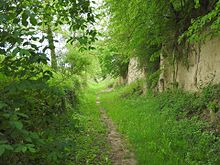At the Red Cross
|
Nature reserve at the Red Cross
|
||
|
Nature reserve at the Red Cross |
||
| location | Ubstadt-Weiher , Karlsruhe district , Baden-Württemberg , Germany | |
| surface | 35.7 ha | |
| Identifier | 2,087 | |
| WDPA ID | 162362 | |
| Geographical location | 49 ° 11 ' N , 8 ° 42' E | |
|
|
||
| Setup date | November 27, 1985 | |
| administration | Karlsruhe Regional Council | |
The Red Cross is a nature reserve in the Kraichgau natural area in Baden-Württemberg near the Zeutern district of the Ubstadt-Weiher community.
geography
The greater part of the protected area consists of spatially separated semi-arid grassland and also includes a small forest area.
description
The area was designated as a nature reserve by ordinance of November 27, 1985 by the Karlsruhe Regional Council and has an area of 36 hectares. It is listed under the protected area number 2.087 and is classified in IUCN Category IV as a biotope and species protection area. The CDDA code is 162362 and also corresponds to the WDPA ID .
The main protection purpose of the nature reserve is the preservation of typical parts of the landscape of the Kraichgau loess landscape, consisting of terraces with steep, dry and hot loess embankments, rain areas, sunken paths, semi-arid grassland and wetlands, as well as the animal and plant communities characteristic of this area.
Flora and fauna
In addition to the orchids and gentians, which are quite typical of the semi-arid grassland, the largest occurrence of the forest anemone in the region can be found here - often in flat stands. The occurrence of the common pasque flower, which was considered common here in the past, is in decline and only limited to one location.
Moss and lichen communities on the vertical, bare flanks of the loess cave paths are of particular interest; an interesting, small moss flora has developed on the warm, dry, south-facing flanks.
The semi-arid grasslands provide habitats for numerous butterflies, some of which are very rare. B. the swallowtail and the yellow ribbon. The uncultivated, sun-exposed loess slopes of the ravine are habitat for the group of animals called the aculeates Hymenoptera - Stechimmen - who mostly dig tubes in the loess wall in order to create their breeding nests there. 106 species from 51 genera have been identified at the site, eight of which are classified as endangered nationwide.
See also
- List of nature reserves in Baden-Württemberg
- List of nature reserves in the district of Karlsruhe
- List of natural spatial units in Baden-Württemberg
literature
- District Office for Nature Conservation and Landscape Management Karlsruhe (Ed.): The nature reserves in the administrative district of Karlsruhe . Thorbecke, Stuttgart 2000, ISBN 3-7995-5172-7
Web links
- Profile of the nature reserve in the LUBW's list of protected areas
Individual evidence
- ↑ Map services of the Federal Agency for Nature Conservation ( information )
- ↑ § 3 Protection purpose ordinance of the Karlsruhe regional council of November 27, 1985, accessed on April 25, 2016
- ↑ Appreciation on the nature reserve "Beim Roten Kreuz" from November 27, 1985, accessed on April 25, 2016






